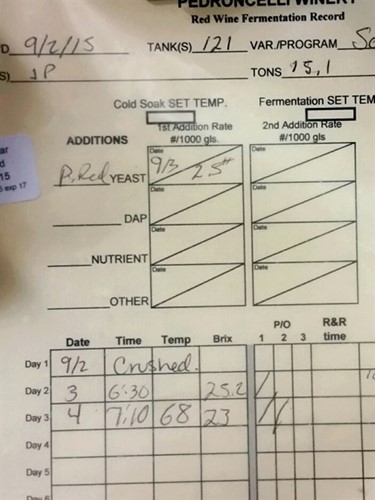Vino In My Dino
Harvest Know how: Berry Maturity
September 4, 2015 14:24
Grapes, like most growing things, have stages they will go through in order to achieve the desired combination of ripeness for a specific wine. I chose today’s post to take a look at our Sangiovese and how it achieves proper maturity for our Alto Vineyards selection.
The four stages of development in grapes range from the green stage, the ripening stage, the ripe stage and the overripe stage. Obviously we target the ripe stage because in this state the resulting wine will benefit greatly when sugar, acid and pH are at their optimum levels. Like the story of the three bears, you want the fruit not too sharp (acidic or green), not overly ripe (alcoholic), but just right.
The composition of a berry on a bunch is comprised of seeds (10%), skin (5-12%), juice (containing fructose and glucose), many nutrients and minerals in minuscule amounts, and water (70-80%). You’ll see in the photo below I have cut a berry in half and then taken out the seeds. These are chestnut brown color; this color is one of the ways to determine the right moment to pick. Sampling, as seen in a previous post, will confirm when the fruit is ready by measuring the sugar, acidity and pH.
Once the fruit was destemmed at the crush pad, the Sangiovese berries (juice, skins, seeds) made their way to the fermenting tank. Here the cellar crew takes an overall look at the combined Brix (sugar), acidity and pH of the 15.1 tons in the tank. There is a total Brix (sugar) of 25.2, total acidity of .765 and pH of 3.11. Over the next 10 days or so, in temperature controlled stainless steel tanks, the fermentation process will convert the sugar to alcohol and it is recorded as seen in the form below.

To give you an idea of these three components in a finished wine here are the stats on our 2012 Sangiovese: alcohol (formerly known as Brix) 14.1%, total acidity is .690g and pH is 3.43. A splash of Sangiovese in my Dino as the harvest continues.
Categories
- COVID
- Follow the Vineyard
- Note from Home
- PairItWithPed
- Pandemic
- pedroncelli
- Port
- Postcards from Home
- Pruning
- Seasons in The Cellar
- Tasting Room
- Thanksgiving
- Vintage Notes
- Winemaking
- Women's History Month
Recent posts
-
A Year Filled With Change
-
Pass Me the Ah So
-
Seasons in The Cellar: Scale House
-
Seasons In The Cellar: Summer Edition
-
What is Grape Veraison
Popular tags
- food and wine
- Cookies
- Crop set
- cooking with wine
- Habit
- Homecooking
- Sonoma County
- Mother Clone
- Sauvignon Blanc
- Library Wine
- 1974 Cabernet Sauvignon
- Block 007 Cabernet Sauvignon
- OpenThatBottleNight
- Harvest 2022
- Schotzki
- Dry Creek Valley
- Pruning
- Rosé
- Recipes
- COVID19
- Down to Earth
- Courage Zinfandel
- Follow the Vineyard
- Pandemic
- Pantry
- Lake Sonoma
- Cabernet Sauvignon
- family
- COVID Coffee Chat
- Springtime
- French Oak
- Oak
- newsletter
- Barrels
- cheese
- Four Grapes Port
- Holding steady
- Finding Your Roots
- Seasons in The Cellar
- Merlot
- American Oak
- Pedroncelli
- note from home
- Anniversary
- Cellar Master
- Heat wave
- Easter
- Sonoma Classico
- Bushnell Vineyard
- PairitwithPed





